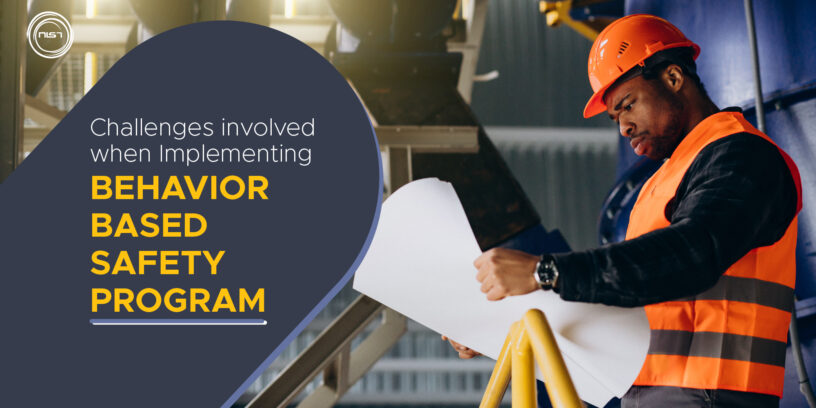Any new safety initiative can face difficulties during implementation. Behavior-Based Safety (BBS) implementation may also face a fair share of challenges, particularly in environments where the safety culture is still developing. We’ll discuss a few of them and how to get around them in order to provide the best answer to this query.
Challenge #1: Undefined Goals
Without well-defined goals, businesses that launch BBS programs quickly transform what would otherwise be a valuable activity into just busy meaningless work. Without knowing why you’re implementing the program and what you hope to gain from it, you’re only observing work with no actual purpose. Sure, you might get a few solid inputs that provide an opportunity for minor adjustments, but overall, you’ll be bombarded with data that may be difficult to act on. Decide what you want the program to do for you before you do anything else, and then set a few “SMART” goals. If you’re unfamiliar with the acronym SMART, it stands for Specific, Measurable, Attainable, Relevant, and Timely. Creating SMART goals can also assist you in keeping your BBS program manageable so that it does not become overwhelming for everyone.
Challenge #2: Collection Process
Another challenge that businesses face when launching a BBS program is the process for collecting observations. The observation method should be straightforward and quick. However, it is common for a company to try to acquire too much information during the observation process, resulting in a tedious, protracted operation that results in improper review. To avoid complications, we recommend running a trial run with whatever form will be used and then asking the workforce for feedback on what they liked and didn’t like about it, what challenges they faced, and how it could be made better or easier to complete. Then take their feedback and apply it to improve the collection procedure. Workers are far more likely to actively participate when they feel like they’re a part of the process and see their thoughts and ideas being treated seriously.
Challenge #3: Lacking Ground Rules
When BBS programs are formed, some things, such as who will run them and how many each individual must complete, are usually set ahead of time. However, issues like as whether the observations will be anonymous, what workers should do when safety violations are discovered during an observation, and whether disciplinary actions will be given when violations are discovered are frequently left unresolved during the design phase. Not having these elements well defined before rolling out the program, as well as not conveying them adequately, will lead to a slew of issues over the program’s lifespan.
Challenge #4: Training
The fourth and last challenge we’ll discuss involves training—but perhaps not the training you’re thinking of. Everyone who has to engage in this program should, of course, be adequately trained on the procedure itself, but there are two other sorts of training that should be considered.
The first is training or coaching in “soft skills” such as adopting the appropriate manner and tone of voice, dealing with conflict, and providing constructive feedback. When a BBS program is launched without even a smidgeon of training in these areas, huge difficulties can arise when employees feel intimidated by the process, targeted, or talked down to.
Additional training on your safe work practices and other mandatory programs is the second form of training to consider. You presumably already provide annual training on these topics, but when you randomly ask staff about the right way to do specific duties and activities, you’d find a lot of differences and deviations from your written policies. This lack of common understanding of how things should be done produces a slew of issues within a BBS program and can lead to erroneous data collection.
What is the Solution?
The best method to prevent this relatively major issue (while also improving overall program understanding) is to divide the BBS program into three or four quarters and provide a list of activities and other procedures that may be monitored throughout each quarter. Make sure there is an up-to-date Standard Operating Procedure (SOP), Safe Work Practice (SWP), and Job Safety Analysis (JSA) for each task or procedure on the list, and require that these things be used during the observation process.
This permits the observation to be conducted based on accurate information, increases everyone’s understanding of the company-approved methods of executing jobs, and guarantees that when training is provided during an observation, the correct information is passed along to workers. As a result, the data obtained is more likely to be good, useable data that can assist identify actual gaps and opportunities for improvement.
Conclusion
Hopefully, the information in this article has given you a better knowledge of some of the issues you may have when developing a BBS program, as well as a few solutions to prevent these challenges. When implemented properly, BBS programs are well worth the effort and can go a long way toward improving your entire safety culture.
At NIST, we offer Consulting & Training services for Behaviour Based Safety. We have a team of industrial safety experts who have robust experience in successfully implementing BBS program for your organization. For further queries, contact our client servicing team @ +91 9384663536 or mail us at corporate.sales@nistinstitute.com














Leave a Reply